Tag archives: quantum computers
Google’s ‘supreme’ 20-qubit quantum computer
By Tushna Commissariat in New Orleans, Louisiana, US
“We should have a 20-qubit chip ready very soon… in the next two months most likely,” says Google’s John Martinis to me as we lean against a wall in a relatively quiet corner of the sprawling convention centre in New Orleans. Martinis, a tall man with a mop of silver hair and an Alan Alda-esque manner, is very busy and I’m lucky to have caught him. Earlier that day, he gave one of the APS March Meeting‘s most popular talks on “quantum supremacy: checking a quantum computer with a classical supercomputer”. Martinis, whose team is based at the University of California Santa Barbara, spoke about how they are working towards developing a “scientifically and commercially useful quantum computer” made up of 50 qubits – a 7 by 7 array of superconducting qubits (each of which is coupled to its nearest neighbour) that can be programmed with a one or two-qubit gate – which has an error rate of about 0.1% and can actually do quantum computations.
View all posts by this author | View this author's profile
Coding and computing: the March 2017 issue of Physics World is out now
Physics these days wouldn’t succeed without software. Whether those lines of code are used to control new apparatus, make sense of fresh experimental data or simulate physical phenomena based on the latest theories, software is essential for understanding the world. The latest issue of Physics World, which is now live in the Physics World app for mobile and desktop, shines a light on how some physicists are exploiting software in new ways, while others are reinventing the hardware of a computer itself – binary isn’t the only way to go.
Sometimes there are so much data that software collaboration is the best way forward. In the issue, physicists Martin White and Pat Scott describe how the GAMBIT Collaboration is creating a new, open-source software tool that can test how theories of dark matter stack up against the wealth of data from various experiments such as direct searches for dark matter and the Large Hadron Collider. And with software development being so essential for physics research, data scientist Arfon Smith argues that we need to adopt better ways of recognizing those who contribute to this largely unrewarded activity. Columnist Robert Crease explores the other extreme: whether software can be patented.
Meanwhile, in an emerging field straddling both coding and computing, researcher Maria Schuld explains how quantum computers could enhance an already powerful software approach known as machine learning. (You can also read her article on physicsworld.com here.) Further into the realm of raw computing, physicist Jessamyn Fairfield describes the quest to develop a new kind of hardware that is physically, and functionally, similar to the computers inside our very own heads. As for how our brains process information, don’t miss a glimpse into the mind of physicist Jess Wade who has created a doodle based on the work Fairfield describes.
View all posts by this author | View this author's profile
Hungry reindeer could mitigate climate change, talking about quantum computing and our breakthroughs of the year

Geoengineering: reindeer can change local albedo. (CC BY-SA 3.0/Alexandre Buisse)
By Hamish Johnston
It’s that time of year when everyone is looking for stories with a Christmassy angle. My colleagues here at IOP Publishing are no exception and they have just put out a press release about some reindeer-related physics. Apparently, hungry reindeer in northern Norway are increasing the albedo of their feeding grounds by eating lots of plants. Albedo is a measure of how much sunlight is reflected back from the surface of the Earth – rather than being absorbed and dissipated as heat – and plays an important role in climate. A worry in the far north is that global warming will lead to greater plant cover – which will reduce albedo and lead to even more warming. Now, it looks like reindeer could help break this cycle. “The effect reindeer grazing can have on albedo and energy balances is potentially large enough to be regionally important,” says Mariska te Beest, from Umeå University in Sweden. “It also points towards herbivore management being a possible tool to combat future warming. Most of the arctic tundra is grazed by either domesticated or wild reindeer, so this is an important finding.”
View all posts by this author | View this author's profile
Looking toward the quantum-technology landscape of the future
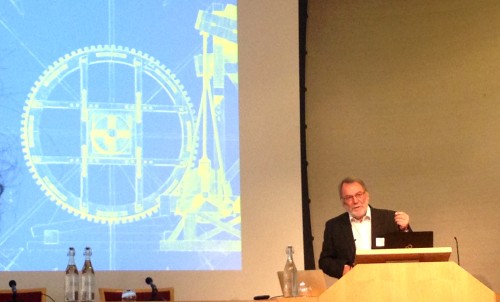
Futuristic views: Peter Knight opening the conference at the Royal Society in London. (Courtesy: Tushna Commissariat)
By Tushna Commissariat
Not a week goes by here at Physics World that we don’t cover some advance in quantum mechanics – be it another step towards quantum computing or error correction, or a new type of quantum sensor, or another basic principle being verified and tested at new scales. While each advance may not always be a breakthrough, it is fair to say that the field has grown by leaps and bound in the last 20 years or so. Indeed, it has seen at least two “revolutions” since it first began and is now poised on the brink of a third, as scientific groups and companies around the world race to build the first quantum computer.
With this in mind, some of the stalwarts of the field – including Peter Knight, Ian Walmsley, Gerard Milburn, Stephen Till and Jonathan Pritchard – organized a two-day discussion meeting at the Royal Society in London, titled “Quantum technology for the 21st century“, which I decided to attend. The meeting’s main aim was to bring together academic and industry leaders “in quantum physics and engineering to identify the next generation of quantum technologies for translational development”. As Knight said during his opening speech, the time has come to “balance the massive leaps that the science has made with actual practical technology”.
View all posts by this author | View this author's profile
IBM wants you to use its quantum computer
By Hamish Johnston
Starting today, members of the public will be able to run programs on IBM’s quantum processor. Users can access the device – which comprises five superconducting quantum bits (qubits) – via the US-based company’s “IBM Quantum Experience” website.
Described as a “cloud-enabled quantum computing platform”, IBM says that users will be able to run algorithms and experiments on IBM’s quantum processor, manipulate individual qubits, as well as access quantum-computing tutorials and simulations.
View all posts by this author | View this author's profile
How to make money by quantum computing
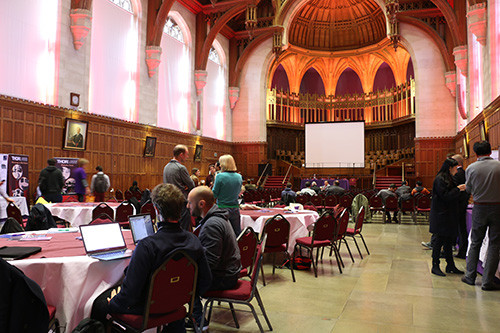
Quantum temple: will the congregation at Bristol’s Wills Memorial Building convert to quantum annealing?
By Hamish Johnston at the BQIT:16 conference in Bristol
Today I have made the short trip from the office to the University of Bristol, which is hosting the BQIT:16 conference on quantum information. I had been looking forward to the “Industry Perspective” session, which was headlined by Steve Adachi of the US defence supplier Lockheed Martin. Several years ago the firm was the first commercial buyer of what some consider to be the world’s first commercial quantum computer – a device made by Canada’s D-Wave Systems – and I wanted to know what Lockheed Martin was doing with it.
To say that D-Wave and its products are controversial is an understatement. Indeed, I wouldn’t be surprised if some delegates to this conference are brought to fisticuffs over D-Wave’s quantum annealing protocols later this evening in Bristol’s cider pubs.
View all posts by this author | View this author's profile
The April 2016 issue of Physics World is now live
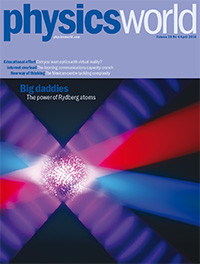 By Matin Durrani
By Matin Durrani
The April 2016 issue of Physics World magazine is ready and waiting for you to access via our app for mobile and desktop.
Our cover story this month is about Rydberg atoms – those super-sized atoms that are one of the hot topics in condensed-matter physics – and in particular how they could be used to create quantum computers.
You can also find out how virtual-reality tools could help you to learn about the science of optics and learn more about a new research centre at the National Autonomous University of Mexico that’s bringing a fresh approach to the science of complexity.
If you’re a member of the Institute of Physics (IOP), you can now enjoy immediate access to the new issue with the digital edition of the magazine in your web browser or on any iOS or Android mobile device (just download the Physics World app from the App Store or Google Play). If you’re not yet in the IOP, you can join as an IOPimember for just £15, €20 or $25 a year to get full access to Physics World digital.
Getting a fix on quantum computations

Bit of choice: A photograph of the nine superconducting qubit device developed by the Martinis group at the University of California, Santa Barbara, where, for the first time, the qubits are able to detect and effectively protect each other from bit errors. (Courtesy: Julian Kelly/Martinis group)
By Tushna Commissariat in New York City, US
Although the APS March meeting finished last Friday and I am now in New York visiting a few more labs and physicists in the city (more on that later), I am still playing catch-up, thanks to the vast number of interesting talks at the conference. One of the most interesting sessions of last week, and a pretty popular one at that, was based on “20 years of quantum error correction” and I went along to the opening talk by physicist John Preskill of the California Institute of Technology. I had the chance to catch up with Preskill after his talk and we discussed just why he thinks that we are not too far away from a true quantum revolution.
Just in case you haven’t come across the subject already, quantum error correction is the science of protecting quantum information (or qubits) from errors that would occur as the information is influenced by the environment and other sorts of quantum noise, causing it to “decohere” and lose its quantum state. Although it may seem premature that scientists have been working on this problem for nearly two decades when an actual quantum computer has yet to be built, we know that we must account for such errors if our quantum computers are ever to succeed. It will be essential if we want to achieve fault-tolerant quantum computation that can deal with all sorts of noise within the system, as well as faults in the hardware (such as a faulty gate) or even a measurement.
Over the past 20 years, theoretical work in the field has made scientists confident that quantum computing of the future will be scalable. Preskill says that “it’s exciting because the experimentalists are taking it quite seriously now”, while initially the interest was mainly theoretical. Previously, scientists would artificially create the noise in the quantum systems that they would correct but now actual quantum computations can be fixed. Indeed, Preskill says that one of the key things that has really moved quantum error correction along in the past few years is the concentrated improvement of the hardware used, i.e. better gates with multiple qubits being processed simultaneously.
Commercial quantum computer works, sort of

Is it or isn’t it? The D-Wave 2X quantum processor. (Courtesy: D-Wave Systems)
By Hamish Johnston
This morning I was speaking to quantum-entanglement expert Jian-Wei Pan, who shares the Physics World Breakthrough of the Year 2015 award for his work on quantum teleportation. Pan briefly mentioned research reported earlier this week by John Martinis, Hartmut Neven and colleagues at Google Research whereby a D-Wave 2X quantum computer was used to perform a computational task 100 million times faster than a classical algorithm.
This is a remarkable result, but does it mean that D-Wave’s controversial processors actually work as quantum computers? Some quantum-computing experts are urging caution in how the research is interpreted.

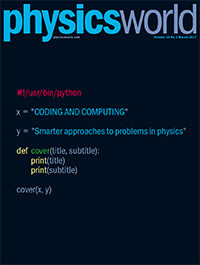
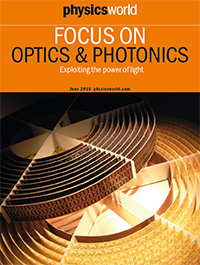 By Matin Durrani
By Matin Durrani